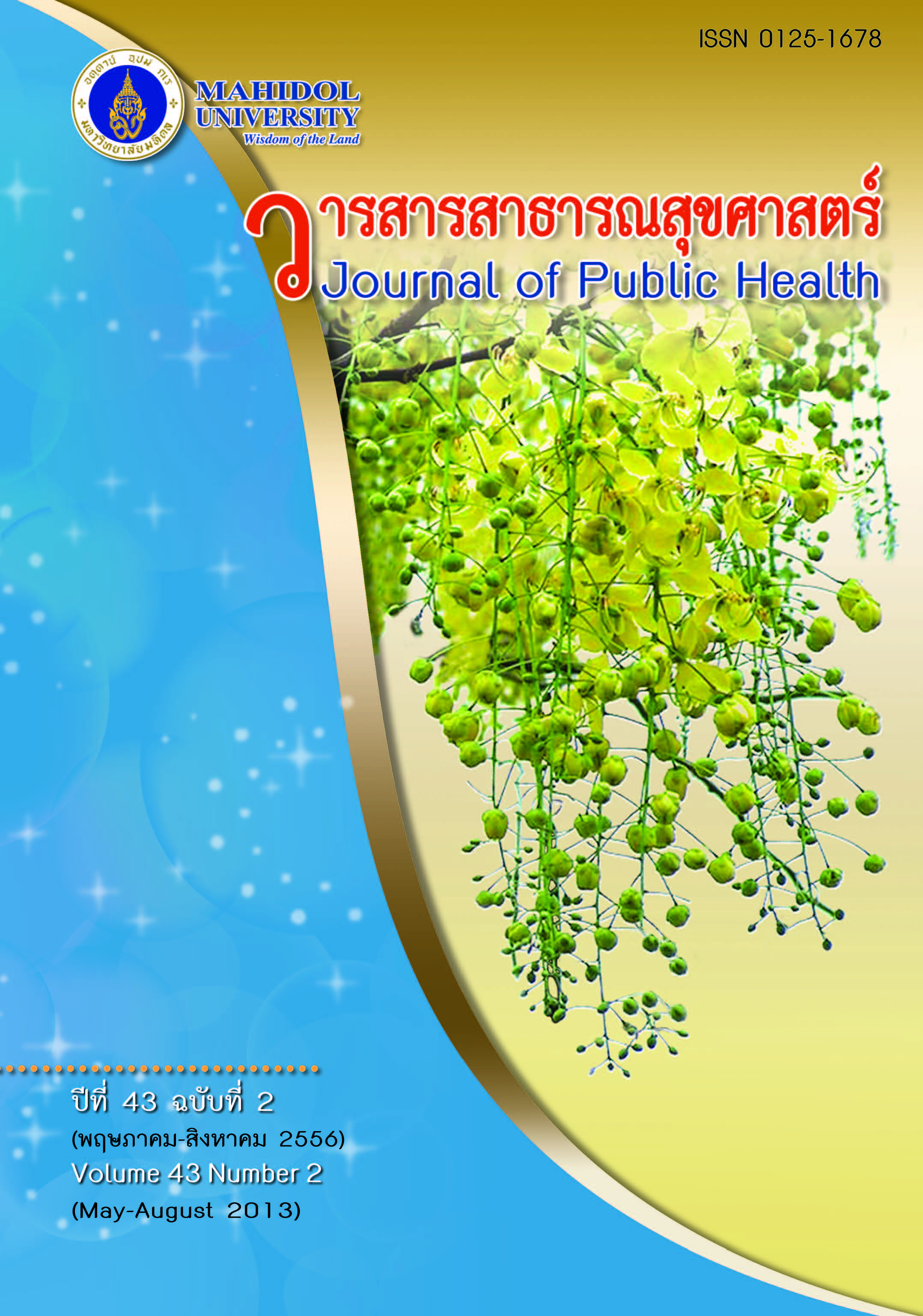ปริมาณไมโครโปรตีนในปัสสาวะของคนงานอู่ต่อเรือที่สัมผัสสารตะกั่วตัวบ่งชี้ความผิดปกติของไต
Keywords:
ตะกั่ว, ยูเรียไนโตรเจน, ครีเอตินิน, ไมโครโปรตีน, การทำงานผิดปกติของไต, lead, blood urea nitrogen, creatinine, microprotein, renal dysfunctionAbstract
บทคัดย่อ
ตะกั่ว เป็นโลหะหนักที่เป็นปัญหาสำคัญต่อสุขภาพ ก่อให้เกิดโรคสมองเสื่อม โลหิตจาง และไตถูกทำลาย วัตถุประสงค์ในการศึกษาครั้งนี้ เพื่อศึกษาพิษของตะกั่วต่อการทำงานของเซลล์เยื่อบุท่อไตในการดูดกลับสารและโปรตีนน้ำหนักโมเลกุลต่ำ โดยการตรวจวัดปริมาณตะกั่ว ยูเรียไนโตรเจน และครีเอตินิน ในเลือด ระดับไมโครโปรตีนและสัดส่วนไมโครโปรตีนต่อครีเอตินิน ในปัสสาวะของกลุ่มคนงานอู่ต่อเรือที่สัมผัสตะกั่วในเขตจังหวัดนครศรีธรรมราช จำนวน 50 คน และกลุ่มควบคุม 40 คน ผลการศึกษาพบว่าร้อยละ 64 ของคนงานอู่ต่อเรือมีระดับตะกั่วในเลือดสูงกว่า 40 ไมโครกรัม/เดซิลิตร ระดับไมโครโปรตีนและสัดส่วนไมโครโปรตีนต่อครีเอตินินในปัสสาวะเพิ่มขึ้นอย่างมีนัยสำคัญเทียบกับกลุ่มควบคุม และเพิ่มขึ้นตามระยะเวลาการสัมผัสตะกั่ว โดยพบสูงสุดที่ช่วงอายุการทำงานตั้งแต่ 21-30 ปี (p<0.05) ในขณะที่ระดับยูเรียไนโตรเจนและครีเอตินินในเลือดอยู่ในระดับปกติ สรุป การสัมผัสตะกั่วเป็นปัจจัยเสี่ยงต่อการทำงานผิดปกติของเซลล์เยื่อบุท่อไต ตรวจพบความผิดปกติได้ในระยะเริ่มต้นของระดับไมโครโปรตีนและสัดส่วนไมโครโปรตีนต่อครีเอตินินในปัสสาวะที่เพิ่มขึ้น สามารถใช้เป็นข้อมูลการวางแนวทางป้องกัน และสร้างเสริมสุขภาพของคนงานอู่ต่อเรือที่ประกอบอาชีพที่สัมผัสกับตะกั่ว
Proteinuria of Lead-exposed Boatyard Workers: The Detection of Renal Dysfunction
ABSTRACT
Lead (Pb) is a heavy metal that poses a major threat to health. It can cause neuro-degeneration, anemia and kidney damage. The objective of this study was to evaluate the effect of lead on renal tubular cell reabsorption of nutrients and low molecular weight proteins. The level of lead, urea nitrogen, and creatinine in blood, and microprotein, creatinine and the microprotein/creatinine ratio in urine were determined. Samples were collected from lead–exposed boatyard workers (n=50) in the wooden-boat repair industry in Nakhon Si Thammarat province and a healthy control group (n=40). The results show that 64 percent of all boatyard workers have high blood lead levels exceeding 40 µg/dL. Microprotein levels and microprotein/creatinine ratios were significantly higher in boatyard workers compared to controls. The microprotein/creatinine ratios were also significantly increased with duration of lead-exposure by boatyard workers. The highest ratios were found in workers with 21-30 years of lead-exposure (p < 0.05). However, the blood levels of urea nitrogen and creatinine, an indicator of renal function, were normal and not significantly different from controls. Conclusion: lead–exposure produces an increased risk of renal tubular dysfunction as shown through early detection of increases in urine microprotein and microprotein/creatinine ratios. These results should be beneficial for future prevention and intervention programs for workers occupationally exposed to lead.
Downloads
Issue
Section
License
Creative Commons License CC-BY-ND


